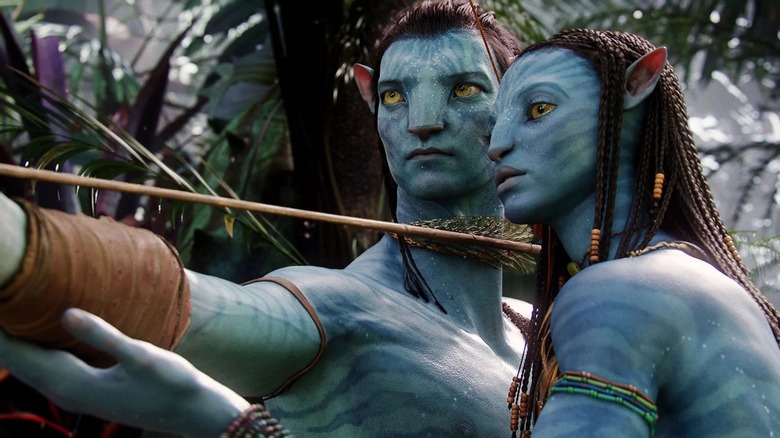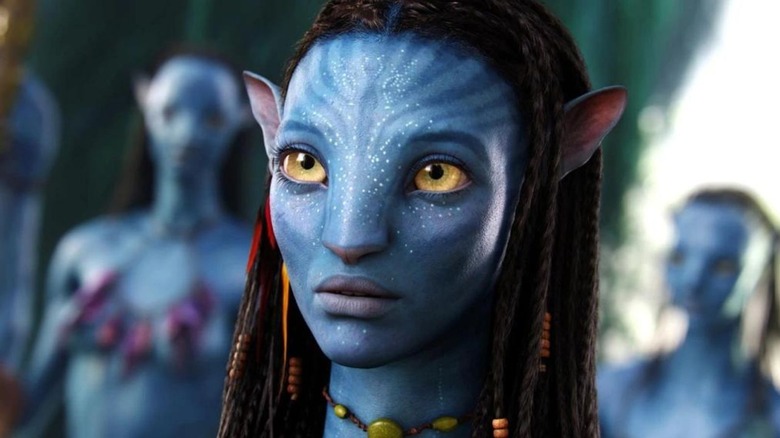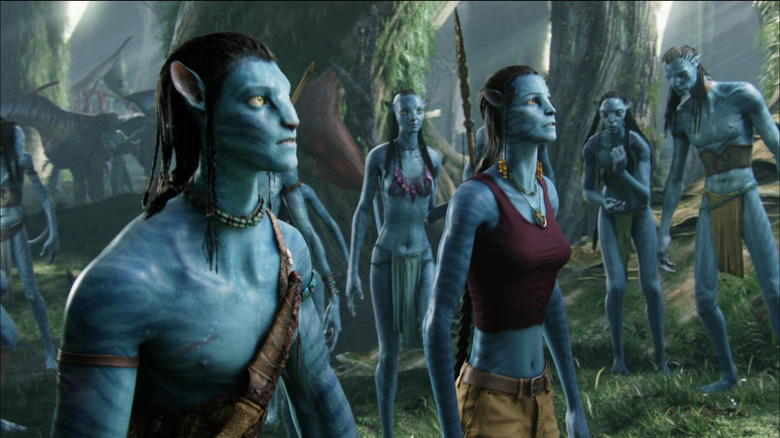Avatar's Na'vi Language Left An Unexpected Amount Of Room For Improv
Teeming with historic technological firsts and advanced never-before-seen cinematic visuals, James Cameron's "Avatar" is historic in both its scope and success. It's the most successful movie in the world for a reason — and it's coming back with a sequel — and will hopefully pave the way for a film franchise of its own.
Cameron wrote and directed the film, which takes place in the 22nd century when the world is suffering from a major energy crisis, and Pandora, an alien moon home to a highly-valuable natural resource, is the only way humanity can save itself. The lush jungle moon of Pandora is home to an indigenous population, a race of sapient, extraterrestrial humanoids called the Na'vi, who have their own culture and traditions, their own set of beliefs, and naturally, their own language. While some Na'vi people can fluently converse in English, others resort to communicating in their language, which we continue to see snippets of throughout the epic science fiction film. Na'vi is not an actual language though — it was constructed for the film.
Linguist Dr. Paul Frommer constructed that language, which incorporated Cameron's original list of about 30 words. In the early stages of developing Na'vi, Frommer presented Cameron with three simple "sound palettes" for his approval. Speaking a fictional language (with difficult pronunciation, might I add) isn't always easy — and it gets more complex when a performer wants to improvise. Fortunately, Sam Worthington, Zoe Saldaña, and the rest of the "Avatar" cast could, with Frommer's help, come up with new things to say in Na'vi that adhered to the fictional language's grammar conventions and stayed consistent with its sound system.
Na'vi incorporated Polynesian and Indonesian sounds
Na'vi is one of the most famous fictional languages of all time — next to Elvish ("The Lord of The Rings"), Dothraki, High Valyrian ("Game of Thrones"), and Klingon ("Star Trek"), among others. While it doesn't consist of as many words as some of the others do (Dothraki has 4,000 words!), Na'vi is constantly developing, and with a second film on the way, there's more to come.
It's tough to make up a language — but harder to create a grammatically sound one. As per filmmaker James Cameron (via NPR), Dr. Paul Frommer, who has a doctorate in linguistics from USC, created the language for the movie. Frommer didn't construct the language entirely from scratch, since he wanted to incorporate the Na'vi names that Cameron had originally come up with. He expanded the sound system, however, and then laid down the rules for building words, phrases, and sentences. Cameron said:
"Well, that's where the linguist, Dr. Paul Frommer, came in. [...] He did more than help. He actually created the language. Or more properly, he created the translations of the lines that we needed for the script. I don't think he didn't create, like, a full language with a vocabulary of 20,000 words, but I think we now have a vocabulary of about 1,200 or 1,300 words."
Frommer helped actors improvise
The linguistics expert accompanied James Cameron on set so he could monitor the actors' pronunciation and guide them whenever they wanted to improvise — which often had him creating words on the spot. There weren't many rules, according to Cameron, except for one: to be consistent with the established sound system and grammar of the language. As the director explained:
"And I actually had him on set with me so that if the actors wanted to improvise, they could go over to him, and say how would I say this, how would I say that? Sometimes he had to create words right on the spot, but they had to be words that were consistent with the kind of sound system that we were using for the language."
Cameron added that while he based some of the character and location names on Polynesian and Indonesian sounds, Frommer brought in sounds found in African, Asian, and Native American languages known as "ejective consonants." A hallmark of Na'vi grammar is free word order; for example, the verb can occur at the beginning, middle, or end of a sentence:
"And I guess I sort of set it in motion when I created character names and place names and based them on some, you know, kind of Polynesian sounds and some Indonesian sounds. And he riffed on that, and he brought in some African sounds that were ejective consonants and things like that, kind of clicks and pops, and he sprinkled those in."
Pronunciation is key
All actors had to stand by a standard, distinct pronunciation, which ensured that the Na'vi language sounded the same when spoken by multiple performers. It was a crucial role for all Na'vi dialogue on set. "It follows linguistic rules, and that's why it sounds correct," James Cameron said. "And all the actors had to adhere to a standard of pronunciation so that it didn't sound like everybody was making up their own gobbledygook, which I think over and a two-and-a-half-hour movie you would have felt you were being had if we had done it that way."
Frommer spent six months developing the Na'vi language and worked on its phonology, morphology, syntax, and initial vocabulary. He translated song lyrics Cameron had written in English and helped actors and vocalists during their on-screen performances and the "Avatar" score recording. There were approximately 1,000 Na'vi words when the film was released in December 2009, although the vocabulary has now grown to about 3,000. Frommer continues to work on the language, which has expanded into different dialects. He also has a blog where he publishes additions to the lexicon and makes clarifications on Na'vi grammar. Pretty cool, right?
Update: This article was adjusted with the assistance of Na'vi language creator Paul Frommer to remove certain inaccuracies.



